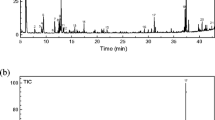Summary
Twenty-eight species of marine Chlorophyceae (5), Phaeophyceae (11), and Rhodophyceae (12) were examined for the occurence of simple volatile amines. The volatile alkaline constituents of the algal samples were extrated by alkaline steam destillation and separated and identified by paper chromatography and microcristallography. A total of 9 volatile amines were found to occur in the species so far examined: methylamine (MA), dimethylamine (DMA), trimethylamine (TMA), ethylamine (ÄA), propylamine (PA), isobutylamine (iBA), isoamylamine (iAA), 2-phenylethylamine (PÄA), and 2-methylmercaptopropylamine (MMPA). MMPA has not previously been reported to occur in any other plant. The occurence of TMA is widespread in marine algae (23 of 28 sp.) whereas an occurrence of DMA could be demonstrated only in two species. MA, which was found in all algal samples, might be formed from labile methylamino-compounds in the course of preparation. Its coccurrence as a natural constituent of algae remains doubtful. Primary amines could be identified in species of each of the three classes of algae, but an especially widespread occurrence was found in Rhodophyceae. With the exception of MA the primary volatile amines, at least those of Rhodophyceae, arise biosynthetically from the corresponding amino acids by enzymatic decarboxylation.
Zusammenfassung
-
1.
28 marine Algen aus den Klassen der Chlorophyceen (5 Arten), Phaeophyceen (11) und Rhodophyceen (12) wurden auf das Vorkommen flüchtiger Amine untersucht.
-
2.
Mit Hilfe papierchromatographischer und mikrokristallographischer Methoden konnten insgesamt 9 flüchtige Amine in Algen nachgewiesen werden: Methylamin (MA), Dimethylamin (DMA), Trimethylamin (TMA), Äthylamin (ÄA), Propylamin (PA), Isobutylamin (iBA), Isoamylamin (iAA), 2-Phenyläthylamin (PÄA) und das bisher aus der Natur nicht bekannte 2-Methylmercaptopropylamin (MMPA).
-
3.
Weitverbreitet findet sich bei Algen Trimethylamin (in 23 von 28 untersuchten Arten), während Dimethylamin nur in 2 Arten sicher nachgewiesen werden konnte. Das natürliche Vorkommen von Methylamin ist nicht gesichert, da dieses Amin möglicherweise erst bei der Aufarbeitung aus instabilen Methylaminoverbindungen entsteht.
-
4.
Primäre Amine kommen in Vertretern aller 3 Algenklassen vor, besonders verbreitet jedoch bei Rhodophyceen (7 von 12 Arten). Biogenetisch werden zumindest die primären Amine der Rhodophyceen, mit Ausnahme von Methylamin, durch enzymatische Decarboxylierung aus entsprechenden Aminosäuren gebildet.
Similar content being viewed by others
Literatur
Channing, D. M., and G. T. Young: Amino-acids and peptides. X. The nitrogenous constituents of some marine algae. J. chem. Soc. 1953, 2481–2491.
Guggenheim, M.: Die biogenen Amine der Planzenwelt. In: Handbuch der Pflanzenphysiologie, Bd. VIII, S. 889 (W. Ruhland, Hrsg.). Berlin-Göttingen-Heidelberg: Springer 1958.
Haas, P., and T. G. Hill: Observations on the metabolism of certain seaweeds. Ann. Bot. 47, 55–66 (1933).
Hais, I. M., u. M. Macek: Handbuch der Papierchromatographie, Bd. I. Jena: Gustav Fischer 1958.
Hartmann, T.: Methode zur quantitativen Trennung und Bestimmung flüchtiger pflanzlicher Amine. Planta (Berl.) 65, 315–333 (1965).
Hartmann, T.: Über eine Leucindecarboxylase aus Meeresalgen. Ber. dtsch. bot. Ges. (im Druck) (1968a).
Hartmann, T.: 2-Methyl-mercapto-propylamin, ein neues Amin aus der Braunalge Desmarestia aculeata. Naturwissenschaften (in Vorbereitung) (1968b).
Kapeller-Adler, R., u. T. Csató: Über das Auftreten von methylierten Stickstoffverbindungen im Seetang. Biochem. Z. 224, 378–383 (1930).
—, u. F. Vering: Über das Auftreten von methylierten Stickstoffverbindungen im Seetang (II) und über einige an Kaltblütern ausgeführte Fütterungsversuche mit Trimethylamin. Biochem. Z. 243, 292–309 (1931).
Katayama, T.: Chemical studies on volatile constituents of seaweed. XIII. On volatile constituents of Laminaria sp. Bull. jap. Soc. Sci. Fisheries 24, 346–354 (1958).
—: Volatile constituents. In: Physiology and biochemistry of algae, p. 467, (R. A. Lewin, ed.). New York: Academic Press 1962.
Klein, G., u. M. Steiner: Stickstoffbasen im Eiweißabbau höherer Pflanzen. I. Ammoniak und flüchtige Amine. Jb. wiss. Bot. 68, 602–710 (1928).
Parke, M., and P. S. Dixon: A revised check-list of british marine algae. J. Mar. biol. Ass. U. K. 44, 499–542 (1964).
Shirahama, K.: On the unsaponifiable matter and phosphatide in marine algae fat. J. Fac. Agr., Hokkaido Univ. 49, 1–93 (1942).
Stein von Kamienski, E.: Untersuchungen über die flüchtigen Amine der Pflanzen. I. Methodik der Trennung und des Nachweises flüchtiger Amine. Planta (Berl.) 50, 291–314 (1957a).
—: Untersuchungen über die flüchtigen Amine der Pflanzen. II. Die Amine von Blütenpflanzen und Moosen. Planta (Berl.) 50, 315–330 (1957b).
—: Untersuchungen über die flüchtigen Amine der Pflanzen. III. Die Amine von Pilzen. Über den Weg der Aminbildung in Pflanzen. Planta (Berl.) 50, 331–352 (1958).
Zorn, B., u. W. Dielmann: Über den Mikronachweis flüchtiger Amine in Körperflüssigkeit und Geweben. Dtsch. Gesundh.-Wes. 8, 1522–1531 (1953).
Author information
Authors and Affiliations
Additional information
Herrn Professor Dr. Dr. h. c. Dr. h. c. Richard Harder zum 80. Geburtstag.
Rights and permissions
About this article
Cite this article
Steiner, M., Hartmann, T. Über Vorkommen und Verbreitung flüchtiger Amine bei Meeresalgen. Planta 79, 113–121 (1968). https://doi.org/10.1007/BF00390154
Received:
Issue Date:
DOI: https://doi.org/10.1007/BF00390154



